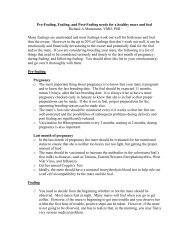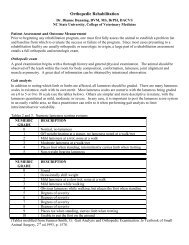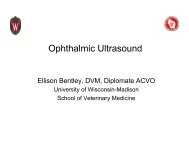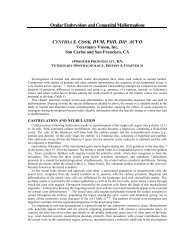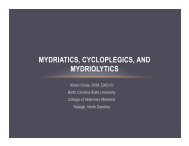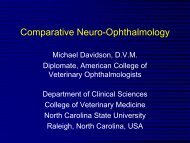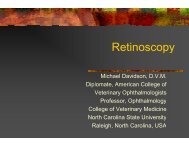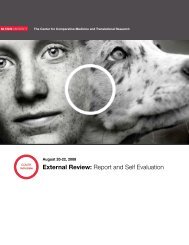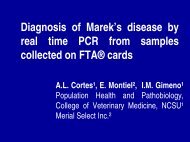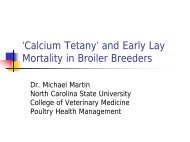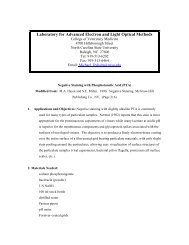Tonometry2012
Tonometry2012
Tonometry2012
Create successful ePaper yourself
Turn your PDF publications into a flip-book with our unique Google optimized e-Paper software.
Tonometry<br />
Gillian J. McLellan<br />
BVMS PhD DECVO DACVO<br />
DVOphthal MRCVS
Objectives<br />
To provide an overview of the theoretical basis and<br />
history of tonometry<br />
To promote discussion of the practical application of<br />
tonometry in clinical veterinary ophthalmology
Glaucoma <br />
------------ 25 mm Hg<br />
Normal <br />
IOP is a measurement<br />
not a diagnosis
DIRECT<br />
Manometry<br />
invasive<br />
IOP Measurement<br />
INDIRECT (estimate)<br />
Tonometry<br />
Contact<br />
Non-contact<br />
Indentation<br />
Applanation
Mercury<br />
Column<br />
Manometry<br />
Courtesy C. Delgado
1622 AD: Richard Bannister<br />
England described the raised<br />
IOP as determined by palpation<br />
of the globe as a distinct sign of<br />
eye disease.<br />
Tonometry Timeline<br />
19 th century –Europeans<br />
bumbling in their<br />
basements<br />
SchiØtz<br />
1905<br />
Many dud<br />
tonometers fill the<br />
junkyard of history<br />
Goldmann<br />
1954<br />
2012 AD :<br />
many “cool” (?), new<br />
tonometers<br />
“is there an app for<br />
that”?
Clinical issues impacting tonometric IOP<br />
Pressure on eyelids<br />
Restraint (including collars)<br />
Blepharospasm and eye movement<br />
Patient posture and head position<br />
Sedation, other drugs administered<br />
Duration of tonometry / multiple measurements<br />
Time of Day<br />
Inter –operator variability<br />
Tonometer type<br />
The patient - e.g. corneal biomechanical properties
Effects of Eyelid Pressure & Restraint<br />
(Klein, HE et al. J Am Vet Med Assoc 2011;238:1292–1295)
Restraint vs vs. vs vs. . no restraint<br />
N=12<br />
animals<br />
Mean<br />
(mmHg)<br />
SD<br />
(mmHg)<br />
Neck restraint 16.4 6.9 8-33<br />
Head restraint 10.2 1.9 7-16.5<br />
No restraint 10.1 0.8 9-13<br />
P value<br />
Neck vs. head 0.00015<br />
No restraint vs. head 0.73<br />
No restraint vs. neck 0.0014<br />
C Delgado , ACVO 2011<br />
Range (mmHg)<br />
(avg 3 readings)
Body Position - Supine Vs Upright<br />
&<br />
Diurnal Curve<br />
John H. K. Liu, 1 Randy P.<br />
Bouligny, 1 Daniel F. Kripke, 2<br />
and Robert N.<br />
Weinreb 1 (Investigative<br />
Ophthalmology and Visual<br />
Science. 2003;44:4439-4442.)<br />
Twenty-four-hour patterns of mean IOP in healthy young adults in the sitting (•) and supine () positions
How to evaluate tonometry papers<br />
Accuracy and Precision<br />
• Target analogy<br />
High accuracy, low precision<br />
vs Low accuracy, high precision
How to evaluate tonometry papers…<br />
Are values compared to manometry?<br />
Accuracy<br />
Is the correlation coefficient close to 1?<br />
is the slope of the regression line close to 1?<br />
Is the under-estimation or over-estimation linear and<br />
consistent over a clinically relevant range?<br />
Reproducibility and Precision<br />
What is the scatter of data?<br />
Are all data points presented or just the means?<br />
Inter-observer variability?<br />
What is the magnitude of departure from “actual” IOP
How to evaluate tonometry papers…
Digital “tonometry”<br />
Indentation tonometry<br />
Variable indentation tonometers<br />
Schiøtz<br />
Based on Maklakoff & Fick’s “law”<br />
W = P x A<br />
For a given weight applied, the greater the<br />
indentation, the lower the pressure<br />
1 scale unit approx = 0.05mm indentation
Schiøtz – Practical Use<br />
Topical anesthesia<br />
Zero using test block<br />
-----------------------------------------------------<br />
Corneal plane horizontal<br />
Gently touch foot plate to axial cornea<br />
Plunger Assembly must be oriented vertically<br />
Add weights to plunger assembly if scale<br />
reading < 5 , or inconsistent readings<br />
Avoid prolonged contact with eye<br />
Conversion table – eg Friedenwald 1955<br />
Disassemble and clean!
Other Factors<br />
1) Conversion tables tables- At least 7 in<br />
veterinary medicine!<br />
2) Tonometer standardization and<br />
maintenance<br />
3) Surface area of indentation<br />
4) Placement on the sclera or<br />
nictitating membrane<br />
5) Duration of indentation<br />
6) Sedatives, anesthetics or<br />
tranquilizers
↓ Force<br />
↑ Force<br />
Schiøtz – Practical Use<br />
Gram weight<br />
Weight of plunger/instrument<br />
Tear film surface tension (pulls plunger towards eye)<br />
-----------------------------------------------------<br />
IOP<br />
Ocular (scleral) rigidity and corneal resistance to bending<br />
Steeper or thicker cornea<br />
Plunger/Tonometer sleeve friction (reduces effect of weight)<br />
Footplate/corneal friction (doesn’t let cornea relax to indent)<br />
Eyelid squeezing & / or Globe retraction<br />
Vascular congestion of the eye (jugular vein compression)<br />
Non-vertical placement - not all of weight applied to cornea
Applanation tonometry<br />
Variable area – fixed weight/ force<br />
Maklakov type<br />
Fixed area – variable weight / force<br />
Goldman type – optical detection of applanation point<br />
Mackay-Marg type – electro-mechanical detection of applanation<br />
point
Maklakov Tonometer, First produced in 1885<br />
A plunger of a known weight is coated with a dye and allowed to rest against the eye with the<br />
patient in a supine position. The tonometer end is then pressed onto special paper and a circle of<br />
dye produced, the diameter of which corresponds to the intraocular pressure. A scale, based on<br />
the plunger weight divided by the area of contact, is placed over the ring converting it into an IOP<br />
value. Tonometers of various weights allow an estimate of ocular rigidity.<br />
Conjoint RANZCO / RVEEH MUSEUM, 2005
Adolph Posner and Richard Inglima, Tonomat, USA 1964<br />
This is a derivative of the Maklakov Tonometer. The cornea is applanated using a standard<br />
weighted probe that has a disposable plastic end plate. An impression is made from the ring<br />
which is then measured with a built in scale.<br />
Conjoint RANZCO / RVEEH MUSEUM, 2005
Imbert Imbert-Fick<br />
Imbert Imbert-Fick Fick law<br />
The force (F) required to flatten a circular area (A) of the surface of a<br />
container which has a relative internal pressure (P) is given as follows :<br />
F=PA<br />
Assumptions - object is spherical, dry, perfectly flexible, infinitely thin and<br />
the container wall contributes nothing to the force equation.
Goldmann applanation tonometry<br />
•Applanation tonometry measures the force required to flatten a known area<br />
(diameter = 3.06 mm) of the cornea<br />
•The eye is not a perfect sphere, but the resistance of the average cornea to<br />
deformation is balanced by the attractive force of the tear film.<br />
•Corneas that are much thicker or thinner than average will affect the reading, but<br />
Goldmann applanation remains the gold standard in clinical practice for physician<br />
ophthalmologists.
Goldmann applanation tonometry<br />
•Apply topical anesthetic and fluorescein<br />
•A cobalt blue filter is used to produce a blue light, and the tonometer prism<br />
is advanced until close to the cornea, then observed through the oculars of<br />
the slit lamp.<br />
•The hemi-circles produced by the prism are brought into alignment by the<br />
operator<br />
•When the inner edges of the hemi-circles are in contact, a circle of cornea<br />
3.06mm in diameter is flattened (displacing ~0.5µl of aqueous humor), and<br />
1gm of force corresponds to 10mmHg IOP, assuming an average corneal<br />
thickness.
Perkins hand held tonometer<br />
•Endpoint operation of the instrument is the same as the<br />
Goldmann<br />
•doubling prism is used to observe two split semi-circles<br />
and a thumbwheel is used to align the fluorescein mires<br />
for an IOP measurement.<br />
•An advantages of this type of Goldmann tonometer is<br />
that it can be used in any position.<br />
•Has been calibrated for sheep, cattle, dogs and cats<br />
•Relies on a clear regular cornea<br />
•Maximal scale reading = 5 ( maximal IOP ≤ 50mmHg)
Mackay Mackay-Marg<br />
Mackay Mackay-Marg Marg applanation tonometry<br />
•1mm central plunger surrounded by<br />
circular footplate<br />
•Electromechanical detection of<br />
plunger displacement<br />
•Mackay-Marg records this<br />
displacement on a paper chart<br />
•Operator reads IOP from the point of<br />
the “dip” on the chart – which<br />
represents the applanation point when<br />
the plunger no longer protrudes from<br />
the footplate and the force of IOP is<br />
taken off the plunger
Mackay Mackay-Marg<br />
Mackay Mackay-Marg Marg applanation tonometry<br />
•Topical anesthesia required<br />
• or IOP about 2 mmHg higher<br />
•Calibrate by gravity (as for tono-pen)<br />
•Use a condom!<br />
•Gently touch probe tip to cornea<br />
•Stages of applanation are reflected on<br />
the tracing
Tono Tono-pen Tono Tono-pen pen<br />
The Tono-pen, a self-contained miniaturized version of the Mackay-Marg electronic, rather than<br />
optical, tonometer, is also a hand-held applanation device with a very small “footprint” on the<br />
cornea, which makes it easier to use with corneal abnormalities and in any position.<br />
A sanitized cover is placed over the tip.<br />
Following topical anesthesia, the Tonopen is gently tapped against the cornea.<br />
It clicks and shows the pressure reading with every valid contact.<br />
When 3-6 valid readings have been obtained it will beep again and display the final averaged<br />
reading, with an indicator showing the confidence of the reading based on the standard<br />
deviation of the averaged values.<br />
NOT ALL TONOPENS ARE CREATED EQUAL (since central plunger reduced to 1mm)
Tono Tono-Pen Tono Tono-Pen Pen vs Tono Tono-Pen Tono Tono-Pen Pen XL<br />
Applanation tonometer with 3.2mm tip<br />
Both the Tono-Pen and Tono-Pen XL are known to<br />
underestimate IOP in cats<br />
Tono-Pen ( slope = 0.73) central plunger 1.5mm<br />
Tono-Pen XL (slope = 0.64) central plunger 1.02mm<br />
Tono-Pen Vet / Avia (slope =???) central plunger -=1.02mm<br />
Miller, P et al (1991) Am J Vet Res, 52, (11) 1917-1921<br />
Passaglia,CL et al (2004) Vet Ophthalmol, 7 (4) 261-264<br />
Stoiber, J et al (2006) Ophthalmic Res, 38, 13-18<br />
Rusanen, E et al (2010) Vet Ophthalmol
Clinical considerations for Mackay Mackay-Marg<br />
Mackay Mackay-Marg Marg<br />
type tonometers<br />
Mackay – Marg highly accurate in dogs and cats<br />
Tono-Pen varies by model<br />
Highly accurate and precise over normal physiological range<br />
Less so at extremes of IOP<br />
Overestimates low IOPs, underestimates high IOPs<br />
Less affected by corneal disease than other types<br />
Artefactual under-estimation of IOP unlikely – so take the lowest<br />
reliable reading<br />
Viscosity of tear film affects the readings (increasing them by about<br />
15% if methylcellulose)<br />
Off center application doesn’ t significantly affect readings
Pneumotonometer
Corneal Biomechanics<br />
• Applanation tonometry assumes:<br />
• cornea offers no resistance to deformation, infinitely<br />
thin, completely dry<br />
• 0.1-0.7mmHg increase in IOP with 10μm increase CCT<br />
• What about corneal stiffness ?<br />
Effect of Corneal Stiffening on Goldmann Applanation Tonometry and Tono-Pen<br />
Measurements in Canine Eyes<br />
(Tang, J et al Invest Ophthalmol Vis Sci. 2012;53 :1397–1405)
ebound tonometer<br />
Schematic for measuring IOP in mice with an induction-impact (I/I) tonometer, which<br />
operates on the rebound principle. Tonometer components and the eye are not drawn<br />
to scale.<br />
Danias et. al. (Investigative Ophthalmology and Visual Science. 2003;44:1138-1141.)
Rebound tonometer<br />
• Probe rebounds faster as IOP increases<br />
• Higher IOP - shorter duration of impact.<br />
• Does not require topical anesthesia.<br />
• Similar reliability to Tono-Pen XL and better accuracy<br />
• Systematic overestimation or underestimation of IOP<br />
• Further assessment of rebound tonometry in<br />
populations with higher IOP and corneal disease, is<br />
needed.
TonoVet<br />
Studies in :<br />
Pigs, Humans, Dogs,Horses,Rabbits , cats<br />
Birds ( but slopes = 0.8 to 1.6 depending<br />
on species)<br />
TonoLab (rodents)<br />
Highly accurate (slope close to 1) in dogs,<br />
cats, horses, rabbits and some avian species<br />
Species differences noted – needs calibration<br />
by species<br />
Rusanen, E et al Vet Ophthalmol (2010) Vet Ophthalmol 13, 31-36<br />
McLellan GJ et al (2012) Vet Ophthalmol , (epub)<br />
Gorig, C et al (2006) Am J Vet Res, 67,1, 134-144<br />
*Leiva et al (2006) Vet Ophthalmol , 9,1,17-21* Compared I-Care to Tonopen XL<br />
Knollinger, AM et al (2005) J Am Vet Med Assoc 227 (2),244-248<br />
Kalesnykas G & Uusitalo, H (2007) Graefes Arch Clin Exp Ophthalmol; 245(5):761-2.<br />
Reuter A et al (2009) ECVO Proceedings<br />
Wang,WH et al (2005) IOVS ; 46, 4617-4621<br />
Morrison JC et al (2009) IOVS, 50,6
Non-contact device that flattens the cornea using a jet of air. An optic receiver detects when<br />
and how fast the cornea has been flattened to a predetermined degree. The unit then converts<br />
the amount of time it takes for applanation to occur into millimeters of mercury. This method’s<br />
advantage lies in the fact that a local anesthetic is not required and potential contamination<br />
from a tonometry cylinder is prevented. However, the measurement is not as accurate as<br />
Goldmann’s tonometry, particularly with high IOP levels.<br />
Patient movement a problem!!<br />
Air Air-puff Air Air-puff puff tonometry
Corneal thickness affects tonometric accuracy<br />
Goldmann realized that corneal thickness and rigidity were important and might influence measurement of<br />
IOP.<br />
The instrument was optimized for an “average” cornea of 520 µm (underestimated , 540 - 550 µm.)<br />
People who have thin corneas have IOP measurements which are lower than true IOP.<br />
People with thick corneas tend to have an IOP measurement higher than true IOP.
THE RELATIONSHIP BETWEEN<br />
CCT AND IOP READINGS<br />
Others report no linear correlation between CCT and IOP, pointing out that<br />
models are dependent on:<br />
population characteristics<br />
presence/absence of OHT<br />
number and type of surgical interventions<br />
ethnic groups<br />
pachymetric techniques<br />
depending on the corneal pachymetric method adopted, may<br />
not be able to confirm the true IOP of subjects<br />
tonometric techniques<br />
each can over or under estimate IOP
THE REICHERT OCULAR RESPONSE ANALYZER® (ORA)<br />
The ORA utilizes an air pulse to apply<br />
force to the cornea and an advanced<br />
electro-optical system to monitor the<br />
resultant corneal deformation.<br />
Alignment to the patient’s eye is fully<br />
automated.<br />
The difference between "inward"<br />
applanation pressure and "outward"<br />
applanation pressures defines<br />
corneal hysteresis, a measure of<br />
ocular rigidity.<br />
RORA measurement may not be possible in the presence of nystagmus
The Proview eye pressure monitor<br />
Has a flat applicator the same diameter as the Goldmann<br />
tonometer<br />
It uses a psychophysical test based on the entoptic phenomenon<br />
of pressure phosphenes, a sensation of light elicited by nonphotic<br />
stimuli, to evaluate IOP.<br />
Not very accurate<br />
Home Home-use Home Home-use use tonometers<br />
Pressure phosephene ring<br />
Diaton<br />
Diaton tonometer also measures IOP<br />
through the eyelid. The measurement<br />
principle is based on the acceleration of a<br />
free falling rod with a known weight and<br />
its interaction with the elastic eye surface<br />
through the eyelid. This tonometer tends<br />
to underestimate IOP.
A new frontier ?<br />
Telemetry<br />
Will allow continuous remote measurement of IOP<br />
All of the devices thus far tested have their<br />
“limitations”<br />
Watch this space
The Pascal DCT<br />
(Swiss Microtechnology, Switzerland) uses a direct<br />
transcorneal method to measure the IOP (Figure). The<br />
device is slit lamp mounted, similar to GAT. The<br />
tonometer tip contact surface is concave. When placed<br />
on the eye, the cornea takes the contour of the tip so that<br />
the corneal mechanical effects on IOP measurement are<br />
reduced. The DCT gathers 100 IOP readings per second,<br />
thus recording dynamic IOP.<br />
Gives an estimation of ocular pulsatility i.e. perfusion?<br />
Optometry Today, Feb. 2005
Acknowledgements<br />
Carol A Rasmussen MS<br />
Paul E Miller DVM



